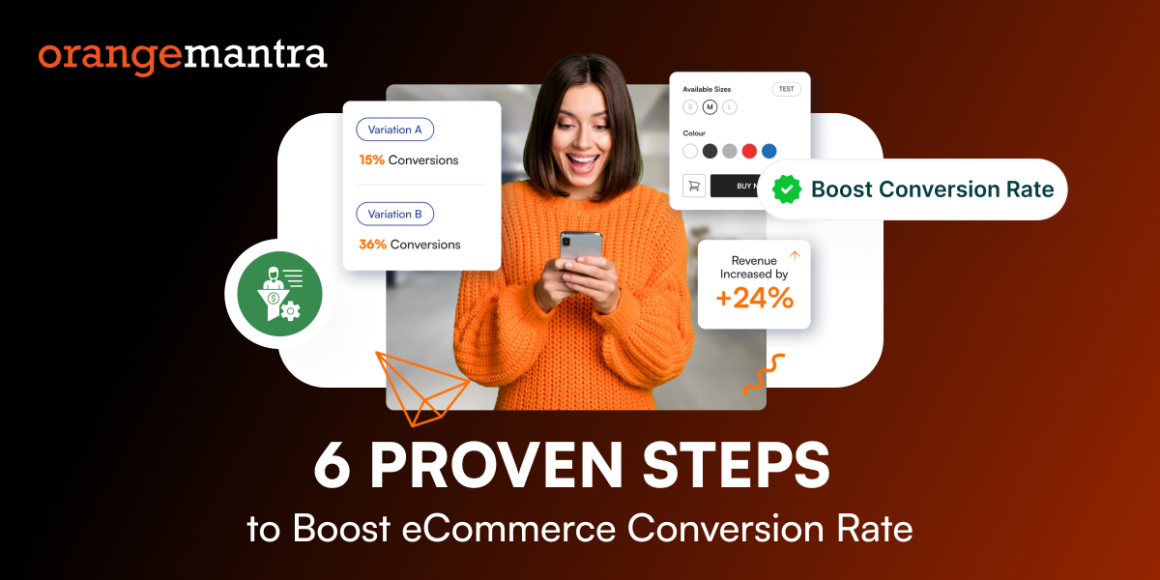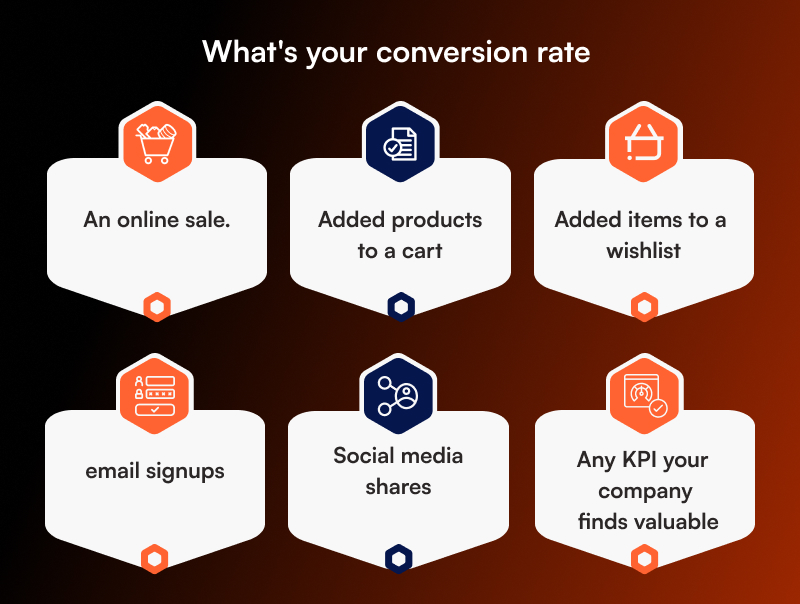For every online business, increasing eCommerce conversion rate is the key to long-term success. If the visitors are coming to your website but they are not buying anything, you won’t make money! Until they buy, your conversion rates will not increase. To grow your eCommerce business, you need to increase your overall conversion rate.
A Basic Understanding of eCommerce Conversion Rate
This means customers end up fulfilling the purchasing journey after visiting your eCommerce store. The entire process of visiting the online store revolves around conversion. These are the basic metrics while you are planning to build your eCommerce store and increase revenue.
Using the right conversion rates, understanding how to optimize your website correctly can specifically increase your overall ROI. For eCommerce web development services, businesses should rely on the companies that use the best tools to improve the quality of websites. As a consequence, the conversion rate for eCommerce businesses will also improve.
Below are the conversions for eCommerce websites:
- An online sale.
- Added products to a cart.
- Added items to a wishlist.
- Email signups.
- Social media shares.
- Any KPI your company finds valuable.
Core Insights of eCommerce Conversion Rate Optimization
Let’s have a look at the insights of the eCommerce conversion rate.
Studies say that $7.31 trillion, marking a 74% increase from 2020’s that were $4.2 trillion, is projected to be spent on the eCommerce retail business by the end of 2025.
Approximately 85% of global consumers shop online, and 95% of purchases are expected to be made through ecommerce by 2040.
According to the latest report by WebFx, Black Friday 2023 saw $9.8 billion in sales, with peak sales reaching $4.2 million per minute, showcasing the frequent visitors who come and stay on the website pages during the festive seasons.
Over 53% of Americans shop on social media at least once per week, emphasizing the importance of integrating social platforms into ecommerce strategies.
Top 6 Steps to Boost eCommerce Conversion Rates
The importance of the eCommerce website can be understood by why companies that are in the field of electronic commerce need to have their store optimized for better sales.
Of all the parameters measured during this process, eCommerce conversion is the most vital one and it is calculated as the percentage of visitors who became buyers of goods offered on a particular website.
Every online shop faces the problem of a low conversion rate, and it is crucial to apply certain measures that will allow the rate to increase constantly.
Now here, we will discuss 6 key actions for effective eCommerce conversion rate optimization for getting desired revenue. Small businesses, along with corporate businesses, will find these tactics and techniques influential in strengthening and improving the eCommerce conversion funnel and boosting sales opportunities to an exceptional level.
Step 1: Enhance Website Speed and Performance
Many factors can contribute to this problem, but the most significant one is when a website is slow in loading when being used for eCommerce. Some statistics supporting this argument reveal that the internet users’ tolerance levels for waiting for a webpage to load are 3 seconds. The fast loading of the site gives the customers a smooth walkthrough in the buying process, thus enhancing the overall eCommerce conversion percentages.
Ways to Optimize Website Speed:
Compress Images: Rather than using large images that make the pages heavy, choose to use small images that can easily be compressed. Others include TinyPNG and ImageOptim, which can be used in the process of optimizing images.
Employ a Content Delivery Network: A CDN helps to distribute the content of the particular site across various locations, which contributes to faster loading of the site.
Use Browser Caching: Save contents from the website on the browsers of the users so that the next time the user visits, it will not have to fully reload the whole page.
Minimize HTTP Requests—you should attempt to reduce the number of requests your site makes by combining files such as CSS and JavaScript.
Lazy Loading: Images should only load when a user scrolls to the part of the page where the image or video is located, which makes the load quick enough.
Upgrade Hosting Plan: If your site gets a lot of visitors, the use of a dedicated or cloud hosting is advisable.
One of the most useful tools that can be found on the Internet for efficient site speed analysis is Google’s PageSpeed Insights; this tool will help to increase the eCommerce conversion rate.
Step 2: Increase Engagement of Product Pages
It is essential to state that the product page is considered to be one of the most critical tools for increasing conversion rates in an eCommerce business. Quite a number of customers fail to complete a purchase because they are not provided with adequate information or else the page is uninviting.
The product page is one of the crucial components of eCommerce and it should follow definite features for it to create a positive first impression on the customers and facilitate the purchasing process to the best extent possible:
Quality images and videos: It is always recommended that to promote the products you sell, it is good to capture them in several instances to make it easy for the buyer to see how the product looks like. Such additional features as interactive spin can create the final and even more appealing and complete look at the product.
Product Features: Particularize what the product is, its functions, properties, and capacities. Dealing with customer objections is also an important part of creating a home for a product, and after identifying these would be the unique selling propositions.
Customer Reviews and Ratings: The more the customer participates in the online feedback, the more confident they become in their purchase decision, thereby increasing the eCommerce conversion rate. Highlight customer testimonials and promote writings that are generated by customers by sharing photos or movies.
Effective use of call-to-action (CTA): This should be designed and placed as a button; some of the most popular and effective buttons include “Buy Now,” “Add to Cart,” or “Limited Time Offer.”
A/B Testing for layouts: It is always very effective to take tests on layouts, buttons, and font styles to determine what commands more action.
The urgency signals include putting a countdown time for the offers that are available for a limited period and low stock notifications.
The target is to design a fabulous product worth buying to stimulate the visitors into buying the products that they set their eyes on and thus enhance the average conversion rate for eCommerce.
Step 3: Simplify the Checkout Process
Peculiarities of a checkout procedure remain one of the primary challenges to organizations seeking to improve the eCommerce conversion rate. A well-implemented checkout process that has little or no barriers makes the customers complete their purchase intentions.
Tips for a Smooth Checkout Process:
Allow the guest to check out: making the client register to be able to complete the purchase hinders him from doing so. Provide an opportunity to register through social networks for faster registration.
Reduce the number of form fields: This means avoiding unnecessary fields such as billing address or phone number when, for instance, the customer is making a one-time purchase and will only require shipping information and a payment option. Autofill and address search can be added bonuses for further optimization of the process.
Various Payment Choices: Clients should be able to pay through credit/debit cards, PayPal, Apple Pay, Google Pay, or through the use of BNPL services.
Security Symbols: Use SSL certificates, trust seals, and money-back guarantees to decrease the customers’ uncertainty. Communicate refund and return policies.
Progress Indicators: This feature should make it easier for the users to know the number of steps remaining in the checkout process to avoid discouraging them from completing it when the steps remaining appear to be many.
Cart Saver: This feature entails enabling users to save their cart for later use meaning that if the users move to a different section before purchasing the products or if they get distracted before completing the buying process, then they can continue from where they left off without the risk of losing any prospective sales.
Many approaches can be used in custom eCommerce solutions or any other online store to increase the convenience of checkouts and ultimately, the percentage of completed purchases, which is called the conversion rate.
Step 4: Leverage Personalization and AI-Driven Recommendations
One of the best practices widely used in eCommerce today is the personalization of the offers and services presented. It is possible for eCommerce stores to personalize shopping experiences through the use of AI and machine learning.
How Personalization Boosts Conversions:
Recommendations: Artificial intelligence incorporated into a user interface identifies the most suitable products and thus brings a higher chance of a purchase being made. It may be used on the product details page, at the checkout and through purchased emails and their recommendations.
Targeted Email Marketing: Based on article content, these include emails to customers in relation to items they have shown interest in, those left in their cart or items they have purchased before. It is another kind of email that has the functionality to adapt the content depending on the activity of the recipient.
Dynamic Content: It’s possible to show homepage banners depending on an interest, discounts and product offers on the homepage.
Facebook Advertising: Use Facebook retargeting, Google AdWords, and Instagram to advertise to those visitors who left without purchasing the products they had looked at.
Since you can integrate AI into the eCommerce conversion funnel, it is possible to achieve a positive impact on the further growth of sales.
Step 5: Optimize for Mobile Shopping Experience
Since mobile devices contribute to over 70% of online buying activities, catering to these devices is not an advantage but a must. A poor experience of the mobile site is damaging to the average eCommerce conversion rate by industry.
Mobile Optimization Best Practices:
Responsive Design: guarantee the site’s compatibility with multiple devices for better and more comfortable usage.
High mobile page speed: To improve page speed, one has to consider using AMP or the accelerated mobile pages. The last two can be resolved by compressing images used on the page and limiting the use of unnecessary scripts and add-ons that may slow the download process and are seen by the user as being rather slow.
Mobile-Friendly Checkout: Use auto-fill features, one-click payment options, and biometric authentication for seamless transactions.
Menu and Filtering: Make sure that the graphical or text menus and filters, as well as the search form, do not pose a problem on mobile devices. The solution is to make use of sticky navigation bars on sites to enhance their performance.
Voice Search: As the use of voice in making purchases rises, web page content and frequently asked questions should be made for voice search.
This way you would be in a position to optimize for mobile, and you will get to attract more shoppers who use mobile devices to engage in eCommerce.
Step 6: Use Social Proof and Trust Signals
It becomes noteworthy to mention that the issue of trust plays a critical role in eCommerce conversion optimization. It is evident that consumers are more willing to purchase products from an online site that is considerate and reasonable.
How to Build Trust and Increase Conversions:
More About the Program: Incorporate quotes and testimonials from real customers who have availed the services to encourage others to come on board. Turn to the video testimonials to add more credibility to the subject.
Trust Indicators: SSL and McAfee are the certifications that must be displayed at the bottom of the page. For instance, it is possible to use such promising guarantees as “100% Secure Payment” or “No-Risk Purchase.”
Social Proof: Describe the percentages of the customers who are happy and satisfied with our products, purchase notifications and live inventory of products. Demonstrate endorsement and social media mentions of the influencers to support the topic.
Money-Back Guarantee: A good way of making customers who may be wary about a purchase decide to make the purchase is to offer them the money-back guarantee for returns and refunds.
This way of increasing trust by using social proof when carrying out eCommerce conversion will help improve the conversion rates and show your audience that your company is credible.
Concluding Thoughts
eCommerce conversion optimization is the key factor for driving growth for your overall business. So, if you are running an eCommerce store, making it easy to convert visitors into clients’ needs a lot of planning. As it has been noted earlier, the above 6 steps can increase the eCommerce conversion rate and ultimately translate to increased sales. When blogs and websites rely on the traffic that comes from social media and search engines, your eCommerce sites need to optimize SEO.
- eCommerce conversion optimization is key to driving growth for your business.
- While blogs and service sites rely on traffic from search engines and social media, eCommerce sites need to optimize SEO at every step of the buying process.
- When starting an eCommerce conversion rate strategy, start by looking into your customer data and website analytics.
- Once you understand what is and isn’t working, start making changes to your website.
- Test each change to make sure it improves conversion rates before rolling out the change to all visitors.
FAQs
Q1. What is a good conversion rate in eCommerce?
Around 2.5-3% is an ideal conversion rate in eCommerce. Average eCommerce conversion rates are around 2.5-3%. Even if you are doing everything right, you can still expect to win the sale around 2-3% of the time. A 3%-plus conversion rate should be the baseline goal for your online store.
Q2. How do you calculate an eCommerce conversion rate?
The ecommerce conversion rate is calculated by dividing the total number of orders placed by the total number of unique visits to your website. For example, if your website had 500 unique visits and 10 orders were placed, your ecommerce conversion rate would be 2% (500 visits / 10 orders = 0.02 or 2%).
Q3. What is CVR in eCommerce?
In e-commerce, CVR, or conversion rate, measures the percentage of website visitors who complete a desired action, such as making a purchase or signing up for a newsletter, indicating the effectiveness of your website and marketing efforts.
























